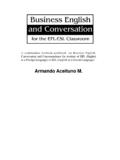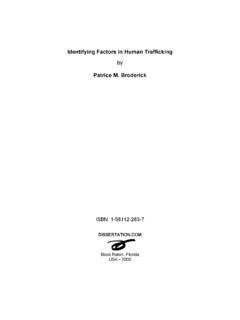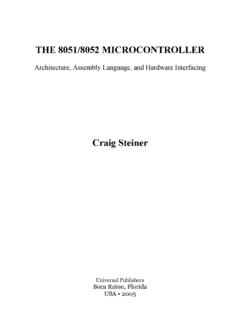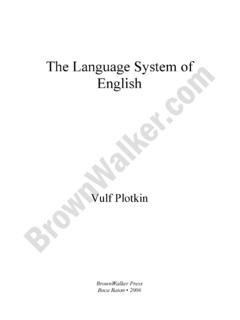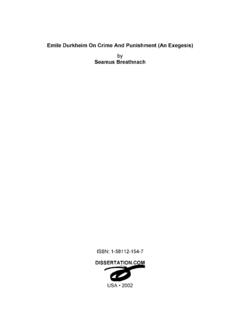Transcription of A SELF-STUDY GUIDE TO THE PRINCIPLES OF ORGANIC …
1 A SELF-STUDY GUIDE TO THE. PRINCIPLES OF ORGANIC chemistry . A SELF-STUDY GUIDE TO THE. PRINCIPLES OF ORGANIC chemistry . Key Concepts, Reaction Mechanisms, and Practice Questions for the Beginner JIBEN ROY. Universal-Publishers Boca Raton A SELF-STUDY GUIDE to the PRINCIPLES of ORGANIC chemistry : Key Concepts, Reaction Mechanisms, and Practice Questions for the Beginner Copyright 2013 Jiben Roy All rights reserved. No part of this book may be reproduced or transmitted in any form or by any means, electronic or mechanical, including photocopying, recording, or by any information storage and retrieval system, without written permission from the publisher Universal-Publishers Boca Raton, Florida USA 2013. ISBN-10: 1-61233-261-7. ISBN-13: 978-1-61233-261-1.
2 Cover image Can Stock Photo Inc. / Marcopolo Library of Congress Cataloging-in-Publication Data Roy, Jiben. A SELF-STUDY GUIDE to the PRINCIPLES of ORGANIC chemistry : key concepts, reaction mechanisms, and practice questions for the beginner / Jiben Roy. pages cm ISBN-13: 978-1-61233-261-1 (paperback : alkaline paper). ISBN-10: 1-61233-261-7 (paperback : alkaline paper). 1. chemistry , ORGANIC -- study and teaching. 2. chemistry , ORGANIC --Problems, exercises, etc. I. Title. 2013. 547--dc23. 2013019602. To 4 W & 1M. Wrishija Wrijoya Writtika Rita &. Manish Contents Preface .. vii About the ix Chapter 1: Introduction to ORGANIC chemistry .. 1. Chapter 2: Atoms, Bonding, Orbitals, Hybridization, Polarity and Electronegativity .. 11. Chapter 3: Resonance.
3 25. Chapter 4: Hydrocarbons and Functional Groups .. 37. Chapter 5: Stereochemistry: Part I .. 47. Chapter 6: Stereochemistry: Part 53. Chapter 7: ORGANIC Reactions ..63. Chapter 8: Reactions of Alkenes .. 73. Chapter 9: Nucleophilic Substitution and Elimination Reaction .. 83. Chapter 10: ORGANIC Analysis Using Spectroscopic Techniques .. 99. Chapter 11: Aromaticity - Benzene and its Reactions ..113. Chapter 12: Alcohols and Phenols ..131. Chapter 13: Carbonyl Chapter 14: Malonic Ester and Acetoacetic Ester Synthesis ..157. Chapter 15: ORGANIC Base: Amines ..163. Chapter 16: Biomolecules Carbohydrates ..171. Chapter 17: Biomolecules - Amino Acids and Proteins ..181. Chapter 18: Biomolecules Lipids: Fats and Oils, Steroids ..189.
4 Chapter 19: Biomolecules Nucleic Acid, DNA and RNA ..195. Chapter 20: Industrial ORGANIC Chapter 21: Synthetic Approach to ORGANIC Chapter 22: Miscellaneous Important Aspects of ORGANIC chemistry ..215. Chapter 23: Sample Exam in ORGANIC chemistry ..225. Chapter 24: Appendix-1: Answer to Additional Questions and Sample Exam ..231. v To the students taking the course of ORGANIC chemistry This book, A SELF-STUDY GUIDE to the PRINCIPLES of ORGANIC chemistry : Key Concepts, Reaction Mechanisms, and Practice Questions for the Beginner is written in plain and simple language and it is formatted as a SELF-STUDY guidebook for the students. For instructors, it is a handbook dealing with all the concepts necessary to understand ORGANIC chemistry .
5 It may not be a comprehensive ORGANIC chemistry textbook, and cer- tainly it is not going to replace the existing comprehensive ORGANIC chemistry textbook, but it has all the elements to build the student's skill and foundation in understanding as well as learning ORGANIC chemistry . This book can be considered as the 21st century Rosetta Stone,' used to study this foreign language, ORGANIC chemistry . By studying this book, students struggling with ORGANIC chemistry will be able to grasp the key concepts easily. Some students taking ORGANIC chemistry are very scared of the class, but this central science sub- ject is a requirement for chemistry majors, biology majors or many more related majors. It is intended for both 2 year and 4 year colleges.
6 Starting with a definition, the book explains atoms, electronic configuration, bonding, hydroca- bons, polar reaction mechanism, stereochemistry, reaction varieties, ORGANIC spectroscopy, aromaticity and aromatic reactions, essential ORGANIC functionalities and their reactions, biomolecules, ORGANIC polymers, and a synthetic approach to ORGANIC compounds. It emphasizes visual conception through the use of structural drawings and mechanisms, with less narrative so that the student can better visu- alize the PRINCIPLES of ORGANIC chemistry . Students will discover how logical ORGANIC chemistry is, and they will certainly need less memorization practicing with pen and paper. Each chapter ends with frequently asked questions and answers, followed by additional practice problems with the answers at the back.
7 The questions and answers section of each chapter is an integral part of the formulae for understanding ORGANIC chemistry . Almost all the most essential concepts in ORGANIC chemistry are introduced in a systematic manner so that the students find them logical, easier, and challenging as well. I am really happy to have found a person like Jeff Young who has built up a publishing company based on publishing unique books at a lower cost while taking care of a worthy manuscript from A to Z. I am thankful to Jeff for selecting and taking care of my book in publication and distribution to the students around the world. I am also indebted to the production editor of my book, Christie Mayer, and cover designer, Shereen Siddiqui, who each did an excellent job on the book.
8 I am thankful to my ORGANIC chemistry students, especially the class of Fall 2012, who have used part of the manuscript and found it effective in their understanding. I am grateful to my colleagues Dr. Dionne Fortenberry, Dr. Ghanshyam Heda, and friends and well-wishers for their encourage- ment. Finally, I would appreciate hearing from the students and instructors about the book and its improvement for the future. _____. Jiben Roy Columbus, Mississippi vii Dr. Jiben Roy is a professor of chemistry in the Department of Sciences and Mathematics, Mississippi University for Women. He earned his in ORGANIC chemistry from the University of Saskatche- wan, Canada in 1983, and went on to complete his post-doctoral fellowship at the Hawaii Natural Energy Institute, University of Hawaii at Manoa 1984-1985.
9 Dr. Roy has established an impressive track record in teaching and research, while also working in the pharmaceutical industry with bulk drugs and formulations, both in the United States and abroad. His publications include An Introduction to Pharmaceutical Sciences: Production, chemistry , Techniques & Technology (2011), ORGANIC chemistry (in Benga- li) (1979), over four dozen other publications, and a co-edited special issue of the journal Current Me- dicinal chemistry . ix 1 Introduction to ORGANIC chemistry Definition of ORGANIC chemistry Sugar, gasoline, peanut butter, plastics, aspirin, paper, milk, cotton, wood, meat, apples, spinach, beer and most of the substances important to life and life styles have one thing common: they all contain the element CARBON (C).
10 Carbon is such a unique and important element that an entire branch of chemistry studying carbon and its compounds is known as ORGANIC chemistry . ORGANIC chemistry is thus the study of the chemistry of carbon containing compounds. Several millions of such com- pounds are currently known. A more appropriate definition of ORGANIC chemistry is: The chemistry of hydrocarbons (compounds of carbon and hydrogen only) and the derivatives of hydrocar- bons, (compounds containing C, H, and O, N, S, P, halogens etc). In some ORGANIC com- pounds, the metals such as Na, K, Ca and many others can be found. These compounds are called organo-metallic compounds. However, there are some exceptions: carbonates (CO3-2), bicarbonates (HCO3-1), cyanides (CN-1).


